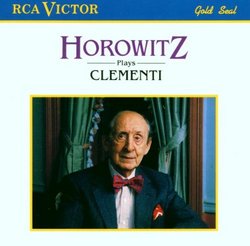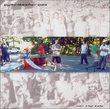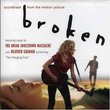| All Artists: Vladimir Horowitz Title: Clementi: Keyboard Sonatas Members Wishing: 0 Total Copies: 0 Label: RCA Victor Europe Original Release Date: 1/1/1989 Release Date: 1/1/1989 Album Type: Import Genre: Classical Styles: Chamber Music, Historical Periods, Classical (c.1770-1830) Number of Discs: 1 SwapaCD Credits: 1 UPC: 035628775320 |
Search - Vladimir Horowitz :: Clementi: Keyboard Sonatas
 | Vladimir Horowitz Clementi: Keyboard Sonatas Genre: Classical
|
Larger Image |
CD DetailsSimilar CDs
|
CD ReviewsImportant and unjustly neglected music by one of the greates Craig Matteson | Ann Arbor, MI | 02/01/2006 (5 out of 5 stars) "While Horowitz was certainly a great virtuoso and made his reputation with the big concerti and solo pieces that constitute the repertoire for a lion of the piano, he was also a maverick. His repertoire was not comprehensive. He did not play every major concerto or sonata. What he did play, he made his own. Then there is the repertoire he brought out that confounded the public. His early programming and recording the sonatas of Domenico Scarlatti generally caused a strong reaction in people (and in some ways his style of playing them still does). Some people thought them beneath a pianist of his stature. When the harpsichord started making a comeback and the idea of proper performance practice began to rise, people criticized his way of playing them too mannered. One person characterized them as the Mona Lisa redone in day-glo paints. Most of us find that we love the way Horowitz plays them as well as the way harpsichordists play them. We don't really have to choose between them. As controversial as that was, when he started programming and recording Clementi sonatas, well, some people lost their minds. This was a completely neglected repertoire and it took a Horowitz to bring attention to its unjustified neglect. Horowitz made a statement by bringing these sonatas to public attention. He even claimed some of them to be on a par with Beethoven. While that is a bit of hyperbole, in the specific it has some real merit (I mean the Opus 49 sonatas?). Most people know Clementi through those sonatinas that every young pianist fumbles with and a few of the exercise of his "Gradus ad Parnassum". There is so much more to this important musician than this! Muzio Clementi (1752-1832) was born in Rome, traveled the world, but made his life and fortune in London. His father was a goldsmith and a devoted amateur musician. He saw to his son's music education. Clementi went to England after a wealthy Englishman named Beckford, impressed with Clementi's playing, offered to see to his music training. In 1770, Clementi was a well equipped musician and took London and then all of Europe by storm. Later he settled down as a successful businessman including the manufacturing and sale of pianos. Although you can hear Clementi as a skillful successor to Scarlatti (listen to the f-sharp minor sonata, Opus 26 No 2, included here), it is quite important to realize his role in the development of the virtuosic piano style (listen to the Sonata quasi Concerto, Opus 33 no 3 and first on this disk) and his contributions to the piano sonata as a form. He wrote more than 100 of them and they deserve more attention than they receive, even today. Clementi was also an influential teacher. Among his students were Field, Cramer, Moscheles, Kalkbrenner, and Meyerbeer. Beethoven was fond of his compositions and you can hear hints of Beethoven in the g-minor sonata, Opus 34 No. 2, included here. This is a fine disk to listen to for enjoyment, for your own musical education, and as an important document of a bold statement by one of the great pianists of history." Fresh Classics, Freshly Played Hank Drake | Cleveland, OH United States | 01/18/2010 (5 out of 5 stars) "Vladimir Horowitz was a tremendously influential musician. His championing of the music of Scarlatti and Scriabin led other pianists to examine that repertoire. Yet despite 30 years of efforts on his part, there was never a Clementi revival during his lifetime.
His efforts began before his retirement in 1953. Shortly after World War II, his wife, Wanda visited a used bookstore in Milan and found a complete original edition of Clementi's piano Sonatas. Horowitz immediately realized these works were pianistically far ahead of their time, noting several passages which were prescient of Beethoven's from decades later. By 1949, he was programming isolated sonata movements. In 1950, he recorded the Rondo from the Sonata in B-flat Major, Op. 24, No. 2, in a witty, flexible performance. Horowitz's most significant contribution to the Clementi discography is the LP dedicated to the composer, which was recorded in 1954. Perhaps wanting to underscore Clementi's "seriousness" as a composer, Horowitz chose minor key Sonatas, including the F-sharp Minor, Op. 25, No. 5 (said to be Beethoven's favorite). It's easy to see why this work would become a Horowitz favorite as well (he performed it publicly in 1974, 1975, and 1982): the lyrical, longing motifs of the first movement are followed by a desolate middle movement, which contrasts with the double-third virtuosity of the finale. There are some arresting moments as well in the G Minor Sonata, which begins with a slow, solemn theme which, after an urgent Allegro, returns, ala Beethoven's Pathetique Sonata. The F Minor Sonata is given a stark rendering which reflects the terseness of the piece. Horowitz performed the Sonata (quasi Concerto) in C Major numerous times between 1976 and 1980. The recording on this CD is taken from rehearsals and performances in Chicago and Washington, DC in April of 1979. Horowitz plays this on a larger scale than the other Sonatas, doubtless to emphasize the work's Concerto aspects. The first movement goes with a great deal of pomp and circumstance. For the second movement, a songful Adagio, Horowitz composed his own cadenza -- which is a bit more advanced tonally than what was heard in Clementi's time (at one point, Horowitz uses a whole tone row). The final movement is played as an outright virtuoso piece, with some left hand accents that would have likely smashed the pianos of Clementi's time. This CD gathers all of Horowitz's Clementi recordings released during his lifetime. The recorded sound varies. The Rondo from 1950 is in acceptable mono. The 1954 items, recorded in the living room of Horowitz's townhouse, fare worst, with a rather constricted, clattery sound. The 1979 Sonata has the up-close sound Horowitz was getting from RCA during that time, but remastering has made it acceptable." |

 Track Listings (13) - Disc #1
Track Listings (13) - Disc #1

